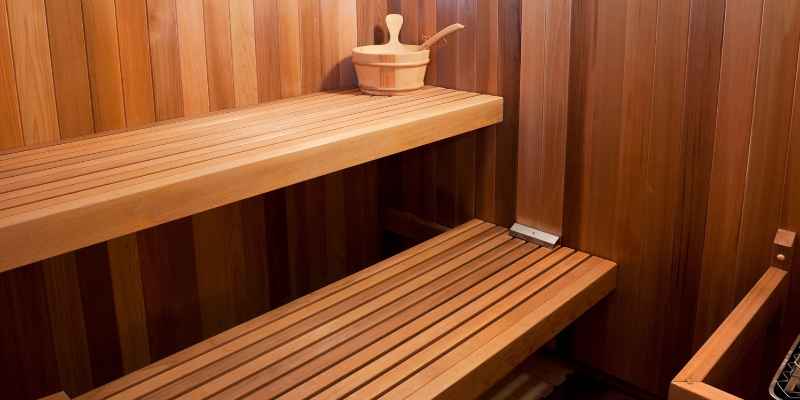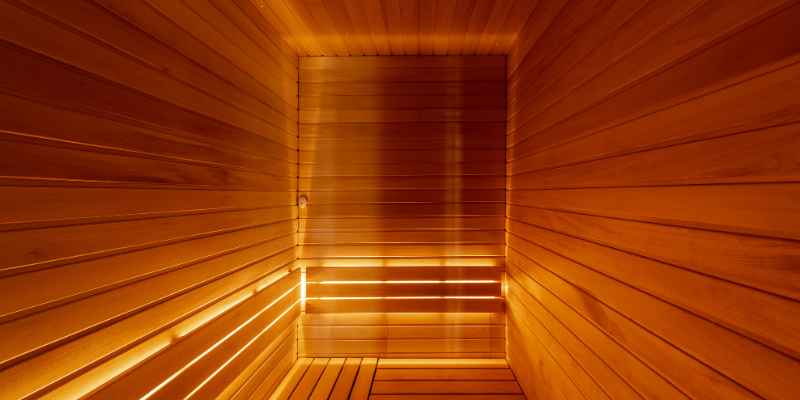For saunas, Western red cedar is the best choice due to its durability and beautiful color. Western red cedar, primarily grown in Washington, Oregon, and British Columbia, is known for its longevity and resistance to decay, making it ideal for sauna use.
This type of cedar provides a comfortable and cooler surface for sitting and leaning in the sauna compared to denser woods. While knots in cedar can weaken over time and potentially compromise the sauna’s integrity, clear cedar is a better option for a long-lasting and aesthetically pleasing sauna.
When selecting cedar for a sauna, it is important to consider the wood’s durability, resistance to decay, and overall comfort for sauna users.
The Essence Of Cedar In Sauna Construction
Cedar is the ideal choice for sauna construction due to its natural resistance to decay and ability to withstand high temperatures. Western red cedar, known for its rich color and durability, is commonly used for its longevity and aesthetic appeal.
Its aromatic properties also enhance the sauna experience, making it a popular choice for sauna construction.
Aromatic Appeal
Cedar wood’s aromatic qualities enhance the sauna experience, emitting a pleasant scent that promotes relaxation.
Thermal Comfort
Cedar’s natural insulating properties help maintain optimal heat levels in the sauna, ensuring a comfortable and soothing environment.

Western Red Cedar: The Traditional Choice
Discover the traditional choice for saunas with Western Red Cedar. Renowned for its striking red to gold color and exceptional durability, this wood is native to Washington, Oregon, and British Columbia. Its longevity makes it a popular and reliable option for sauna construction.
When it comes to building a sauna, choosing the right type of wood is crucial. One wood that has stood the test of time and is considered the traditional choice for saunas is Western Red Cedar. Not only does it boast a beautiful reddish-gold color, but it also offers exceptional longevity, making it an ideal option for sauna construction.
Color And Longevity
The distinct color of Western Red Cedar adds an aesthetic appeal to any sauna. Its reddish-gold hue creates a warm and inviting atmosphere, enhancing the overall sauna experience. Additionally, this type of cedar is known for its exceptional durability, ensuring that your sauna will last for years to come.
Western Red Cedar is naturally resistant to rot, decay, and insect infestation. This natural resistance is due to the presence of natural oils and extractives in the wood, which act as a protective barrier against moisture and pests. As a result, saunas built with Western Red Cedar require minimal maintenance and can withstand the high temperatures and humidity levels typically found in saunas.
Geographic Origins
Western Red Cedar is primarily grown in Washington and Oregon, as well as British Columbia. These regions provide the ideal climate and soil conditions for the growth of this species, resulting in high-quality cedar with desirable properties for sauna construction.
The geographic origins of Western Red Cedar contribute to its exceptional quality and durability. The wood from these regions is known for its tight grain, which adds strength to the wood and enhances its resistance to cracking and warping. Saunas constructed with Western Red Cedar sourced from these areas ensure a long-lasting and reliable sauna experience.
Overall, Western Red Cedar is the traditional choice for sauna construction due to its beautiful color, exceptional longevity, and geographic origins. Its natural resistance to moisture, pests, and decay make it the ideal wood for creating a sauna that will stand the test of time.
Comparing Cedar Types
When it comes to selecting cedar for a sauna, Western red cedar is a popular choice due to its beautiful color and durability. It is primarily grown in Washington, Oregon, and British Columbia. Avoid using woods with toxic properties or low durability, such as yew or poplar, as they are not suitable for high-temperature and high-humidity environments like a sauna.
Clear cedar is recommended over knotty cedar to ensure structural integrity.
Western Red Vs. White Cedar
When it comes to choosing the ideal cedar for your sauna, understanding the differences between Western Red and White Cedar is crucial. Let’s take a closer look at the unique characteristics of each type of cedar.
Red Cedar’s Unique Advantages
Red Cedar stands out for its exceptional durability and stunning natural color variations, ranging from rich reds to warm gold tones. It is a popular choice for sauna construction due to its resistance to decay and ability to withstand high temperatures and humidity.
Ideal Thickness For Sauna Cedar
The ideal thickness for sauna cedar is a crucial factor to consider when building or renovating a sauna. The thickness of the cedar wood used in a sauna can impact its durability, insulation, and overall performance. Understanding the ideal thickness for sauna cedar is essential for creating a comfortable and efficient sauna experience.
Standard Measurements
When it comes to sauna cedar, the standard thickness typically ranges from 1 3/8 inches to 1 3/4 inches. These measurements are commonly used in the construction of sauna walls, benches, and paneling. The uniformity of the cedar planks ensures structural integrity and heat retention within the sauna environment.
Impact On Heat Insulation
The thickness of the cedar wood directly affects the heat insulation properties of the sauna. Thicker cedar planks provide better insulation, helping to maintain a consistent and comfortable temperature inside the sauna. The thermal efficiency of the sauna is significantly influenced by the thickness of the cedar used, as it contributes to heat retention and energy conservation.
Woods To Avoid In Sauna Making
When building a sauna, it’s crucial to select the right type of wood to ensure a safe and durable environment. Some woods are not suitable for sauna making due to their toxic properties and low durability.
Toxic Woods
Wood with toxic properties, like yew, can be harmful when heated in a sauna and may cause health issues. It’s important to avoid using woods with known toxic elements to maintain a safe sauna environment.
Low Durability Species
Woods with low durability, such as poplar, are not ideal for sauna construction as they may not withstand the high temperatures and humidity levels of a sauna. Opting for more durable wood species will ensure the longevity of your sauna.
Choosing Between Knotty And Clear Cedar
For sauna construction, opt for clear cedar over knotty cedar due to its superior durability and resistance to rot. Clear cedar, with fewer knots, ensures better structural integrity and longevity, especially for outdoor saunas where knots may lead to leaks.
Choose quality for a blissful sauna experience.
Aesthetics Versus Function
When it comes to choosing between knotty and clear cedar for your sauna, aesthetics and function are two important factors to consider. Clear cedar is known for its uniform color and lack of knots, making it a popular choice for those who prioritize a sleek and modern look. However, clear cedar tends to be more expensive than knotty cedar, which has a more rustic appearance due to its knots and color variations.
Outdoor Sauna Considerations
If you’re planning to build an outdoor sauna, it’s important to choose a wood that can withstand the elements. Cedar is a popular choice for outdoor saunas because of its natural resistance to rot and decay. However, it’s important to note that knotty cedar may be more prone to cracking and warping over time, especially if it’s exposed to direct sunlight or moisture. Clear cedar, on the other hand, may be more stable and durable in outdoor environments.
When choosing between knotty and clear cedar for your sauna, it’s important to consider your priorities. If you value aesthetics and are willing to pay a higher price for a uniform appearance, clear cedar may be the best choice for you. However, if you prioritize function and want a wood that can withstand the elements, knotty cedar may be a more practical option.
| Clear Cedar | Knotty Cedar |
|---|---|
| Uniform color | Rustic appearance |
| No knots | May have knots and color variations |
| Expensive | Less expensive |
| More stable and durable | May be more prone to cracking and warping |
Overall, choosing between knotty and clear cedar for your sauna depends on your personal preferences and priorities. Both types of cedar have their own unique benefits and drawbacks, so it’s important to weigh the pros and cons before making a decision.
The Debate: Is Cedar Essential?
Cedar is one of the most popular choices for sauna wood due to its natural resistance to decay and durability. Western red cedar is the most commonly used type of cedar for saunas due to its beautiful color and longevity, while wood types such as yew and poplar are not recommended.
Clear cedar is preferred over knotty cedar to prevent structural issues.
When it comes to building a sauna, the choice of wood is crucial. Cedar has long been the preferred wood for saunas, but is it truly essential? Let’s explore the debate surrounding the use of cedar in saunas.
Alternatives To Cedar
While cedar is a popular choice for saunas, there are alternatives worth considering. Hemlock and aspen are two viable options that offer similar durability and resistance to moisture. Each wood has its own unique characteristics, so it’s important to consider the specific requirements of your sauna project when exploring alternatives to cedar.
Cedar’s Role In Sauna Experience
Cedar plays a crucial role in enhancing the sauna experience. Its natural aroma and heat-resistant properties contribute to a more pleasant and relaxing environment. The aromatic scent of cedar adds to the sensory experience of using a sauna, while its ability to withstand high temperatures and humidity makes it an ideal choice for sauna construction.
Cedar Lumber & Paneling Specifics
When it comes to choosing cedar for a sauna, Western red cedar is the best option due to its beautiful color and durability. It is primarily grown in Washington, Oregon, and British Columbia, making it a reliable choice for sauna construction.
Avoid using wood with toxic properties or low durability, such as yew or poplar, as they are not suitable for high-temperature and high-humidity environments like saunas. Consider the extra cost of clear cedar over knotty cedar for long-lasting sauna bliss.
Comfort And Coolness
Cedar lumber and paneling are known for providing exceptional comfort and coolness in saunas. The natural insulating properties of cedar help in maintaining a comfortable temperature inside the sauna, ensuring a relaxing and enjoyable sauna experience for the users. The cool-to-the-touch surface of cedar wood further enhances the comfort level, making it an ideal choice for sauna construction.
Natural Repellence
Cedar lumber and paneling exhibit natural repellent properties that make them highly suitable for sauna use. The natural oils and resins present in cedar wood act as a defense mechanism against moisture, mold, and mildew, ensuring a hygienic and low-maintenance sauna environment. Additionally, the distinct aroma of cedar adds to the overall sensory experience, creating a soothing and rejuvenating ambiance inside the sauna.
Sourcing And Pricing Cedar For Saunas
Discover the best cedar for saunas – Western Red Cedar, prized for its rich hue and durability. Avoid toxic or low-durability woods like yew or poplar, ensuring a safe and long-lasting sauna experience. Opt for clear cedar over knotty for superior structural integrity and aesthetic appeal.
Finding the right cedar for your sauna is crucial to creating a comfortable and relaxing environment. Western red cedar is the most popular choice for saunas, thanks to its natural resistance to decay and insect infestation, as well as its pleasant aroma. However, sourcing and pricing cedar for your sauna can be a challenging task. In this section, we will discuss the steps you can take to find quality suppliers and compare costs effectively.
Finding Quality Suppliers
When it comes to finding quality cedar suppliers for your sauna, you want to make sure you are dealing with a reputable company. Here are some tips to help you find the right supplier:
- Do your research: Look for online reviews and testimonials from previous customers to get an idea of the supplier’s reputation.
- Ask for samples: Request samples of the cedar to ensure that it meets your requirements in terms of color, texture, and scent.
- Check certifications: Ensure that the supplier has all the necessary certifications, such as FSC and PEFC, to guarantee that their cedar is sustainably sourced.
Cost Comparison
Comparing costs between different cedar suppliers can be daunting, as prices can vary widely depending on the quality and grade of the cedar. Here are some factors to consider when comparing costs:
| Supplier | Price per Sqft | Discount |
|---|---|---|
| SuperiorSaunas.com | $7,479.35 | $4,247.99 |
| PolarSauna.com | $5,574.20 | LOW PRICE |
| CherokeeWood.com | $1.95 | N/A |
- Grade: Cedar is graded by its quality and appearance, with clear cedar being the highest grade and knotty cedar being the lowest. Clear cedar is more expensive than knotty cedar.
- Thickness: The thickness of the cedar can also impact the price, with thicker boards being more expensive.
- Supplier location: The location of the supplier can also impact the price, with local suppliers being more affordable due to lower shipping costs.
By considering these factors and comparing costs between different suppliers, you can find the best cedar for your sauna at a reasonable price.
In conclusion, sourcing and pricing cedar for your sauna requires careful research and consideration. By finding quality suppliers and comparing costs effectively, you can create a relaxing and comfortable sauna experience that will last for years to come.
The Craft Of Sauna Building
When considering cedar for sauna building, Western red cedar is a popular choice due to its rich color and durability. It is primarily sourced from Washington, Oregon, and British Columbia, making it a reliable option for sauna construction. Clear cedar is preferable over knotty cedar to maintain structural integrity and prevent potential leaks in outdoor saunas.
Diy Cedar Sauna Tips
When embarking on a DIY cedar sauna project, consider these essential tips:
- Choose Western Red Cedar: Opt for this durable and aesthetically pleasing wood for longevity.
- Ensure Proper Ventilation: Proper ventilation is crucial for a safe and comfortable sauna experience.
- Seal Joints Carefully: Use high-quality sealant to prevent heat and steam from escaping.
- Follow Safety Guidelines: Adhere to safety guidelines to ensure a secure sauna environment.
Professional Installation Insights
For those opting for professional installation of a cedar sauna, here are some insights to consider:
- Choose Experienced Installers: Select professionals with expertise in sauna construction for a high-quality finish.
- Discuss Customization Options: Communicate your preferences for a customized sauna experience.
- Quality Assurance: Ensure that the materials used meet industry standards for durability and safety.

Frequently Asked Questions
What Type Of Cedar Is Best For A Sauna?
The best type of cedar for a sauna is Western Red Cedar. It is traditionally used for saunas due to its beautiful red to gold hue and its durability. Western Red Cedar is primarily grown in Washington, Oregon, and British Columbia.
It provides a comfortable and cooler surface to sit and lean on compared to denser sauna woods. Avoid using wood with toxic properties or low durability, such as yew or poplar. Clear cedar is preferred over knotty cedar for better structural integrity.
What Thickness Of Cedar For Sauna?
For a sauna, the best type of cedar to use is Western red cedar. It is known for its beautiful color and durability, and is primarily grown in Washington, Oregon, and British Columbia. In terms of thickness, it is recommended to use 1×4 or 1×6 tongue and groove cedar boards.
Avoid using wood with toxic properties or low durability, such as yew or poplar. Clear cedar is preferable over knotty cedar to prevent structural integrity issues.
What Wood Is Not Good For Sauna?
Avoid wood with toxic properties like yew and low durability such as poplar for saunas.
Is Knotty Or Clear Cedar Better For Sauna?
Clear cedar is better for saunas than knotty cedar. While both types are resistant to rot and decay, knots in knotty cedar can loosen and compromise the sauna’s structural integrity over time. Clear cedar provides a stronger and more reliable option for building a sauna.
Conclusion
When it comes to choosing cedar for your sauna, Western red cedar is the top choice. Its beautiful color and durability make it ideal for sauna construction. Avoid using wood with toxic properties or low durability, such as yew or poplar.
Additionally, clear cedar is recommended over knotty cedar for better structural integrity. Choose the best cedar for your sauna to ensure a comfortable and long-lasting experience.


